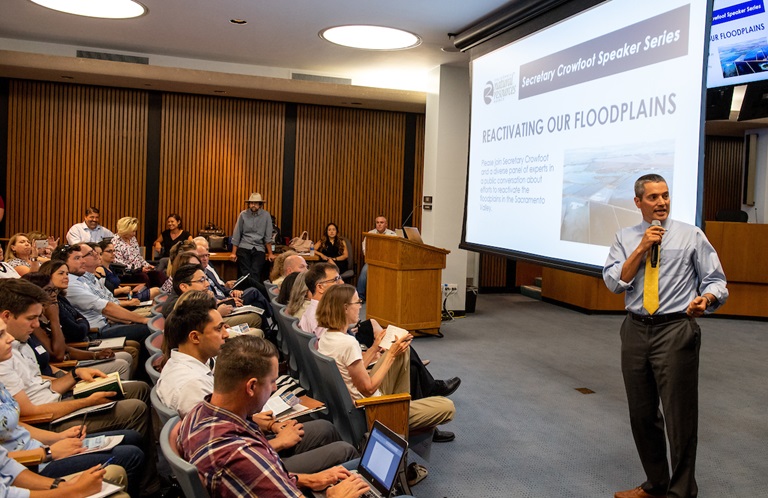Secretary Crowfoot: Reactivating Natural Floodplains in Central Valley is a Win-Win
Wade Crowfoot, California Secretary for Natural Resources, introduces "Reactivating Our Floodplains," the first in the CNRA Speaker Series. DWR/2019
At his inaugural Speaker Series on July 15, California Secretary for Natural Resources Wade Crowfoot led a discussion on restoring local wildlife species and habitats by reactivating floodplains.
The Secretary’s Speaker Series provides a public discussion on emerging ideas and priorities in the natural resources arena. It is an opportunity for Secretary Crowfoot and a diverse panel of experts to inform the public on plans to improve the environment through science and policy.
“So much in water policy in the state can be characterized as conflict; fish versus farm, urban versus rural, north versus south. One important priority of Governor Newsom is to try to break through that old paradigm to find ways that work across different stakeholder groups,” Crowfoot said to a standing-room-only audience of about 200 people at the California Natural Resources Building in Sacramento.
“Finding ways to reactivate the natural floodplain in the Central Valley is one of those win-win solutions,” he said.
Several partner agencies and non-governmental organizations also spoke to the multiple benefits provided by the strategy to reactivate California’s floodplains.
“The new way forward is really figuring out how to make every acre of land have multiple benefits: make it work for people growing food; make it work for birds who need winter or summer habitat; make it work for fish; and to use the limited resources we have as smartly as possible,” said Megan Hertel of the National Audubon Society.
Reactivating floodplains by introducing water onto farmed rice fields creates several benefits. The strategy breaks down rice field waste in a natural manner, while also restoring wetlands and local wildlife species. Eliminating narrow leveed water banks allows water to naturally spread throughout the Central Valley, providing opportunities for increased bug populations, a main food source for local fish and bird species.
Studies show clear evidence of increased growth rates in juvenile fish reared in nutrient-dense floodplains.
Jacob Katz, senior scientist at California Trout, refers to them as “floodplain fatties.” When these larger, healthier fish enter the Sacramento River to continue their migratory journey, they have better odds of survival. Restored floodplains are also a boon for migrating bird populations that rely on California wetland habitat.
“We can do this -- we can bring the salmon back. We can recreate this lost habitat. California is asking us to get that done,” said Chuck Bonham, director of the California Department of Fish and Wildlife. “And in the immortal words of Dr. Seuss: Unless someone like you cares a whole heck of a lot, nothing is going to get better. It’s not.”
